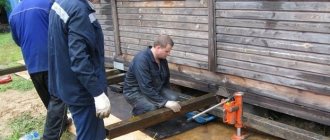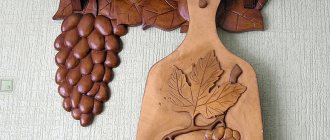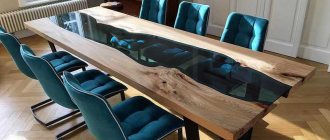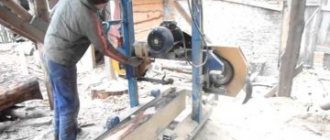Dugout boat - a homemade boat made of solid wood
In our opinion, another type of small vessel has been undeservedly forgotten. We are talking about a dugout boat. Behind its apparent simplicity and “absurdity” are hidden both the rationality of the design and excellent driving performance. The absence of scarce materials and the minimum set of required tools make it possible to manufacture such a dugout boat directly on the shore, far from populated areas, in hunting or fishing areas. For many decades, the secrets of boat masters were passed on “by word of mouth,” from father to son, without drawings or calculations. And since a limited number of people were engaged in this trade, today it is very difficult to find a specialist who can competently, according to all the rules, make a real dugout. This is aggravated by the fact that now, in the era of modern materials and technologies, there are practically no masters of the younger generation, and the old ones, unfortunately, take their experience and skill with them: their art dies with them. That's why we decided to introduce homemakers to the process of making a dugout boat .
Perhaps some of them will be interested in this topic. We hope that the traditions of folk crafts will be preserved and continue with their help, bringing benefits. When describing the procedure for working on a boat, we proceed from the capabilities of a single craftsman, without the use of machine tools or any lifting mechanisms. However, in any case, both the manufacturing process and the boat itself will bring you real pleasure.
Mast
Without a small mast with a sail, the job will look unfinished. I used a drill bit that was about the same diameter as my dowel. Do not forget that they must match each other - in this case you will not have to use glue. After turning a round mast from the board, insert it into the hole. If it doesn't fit tightly, you'll have to use glue and tape to narrow the diameter, so it's best to work gradually.
I also drilled tiny holes at the ends of the mast into which I inserted threads. They will hold the sail, which will make the toy even more interesting. It can be made from fabric. Use durable material and trim the edges to prevent it from unraveling prematurely. When working correctly, the sail can even guide your small boat when it is lowered into the water.
Swollen eyes, dizziness and other possible reactions to the COVID-19 vaccine
I prepared lazy sausages in dough: I put bagels on the sausages and baked them
The black part in the head of the shrimp: many people do not know whether it is edible or not
General recommendations for building a dugout boat
When getting started, there are a few things to keep in mind:
1. Don’t start making a big boat right away. An unprepared person may not be able to do this. It would be more correct to try a version 3–4 meters long.
2. Do not neglect the recommendations regarding the choice of material, size, and time of cutting wood. They are dictated not by our whim, but by many years of observations of more than one generation. This is exactly what our great-grandfathers advised.
3. The proposed technology and terminology takes place in our places, in the Krasnoyarsk Territory. Of course, it may differ in other areas. Keep this in mind to avoid confusion.
4. Don’t forget about the accumulated experience in amateur shipbuilding. Various additional literature is very useful for work, especially if a beginner takes it on.
Final sealing of the joints of the bottom and side plating sheets
After the glue has dried, you will need to lay two canvas strips, thoroughly soaked with epoxy glue, along the inside of the junction of the side and bottom skin sheets.
From the outside, the seam needs to be reinforced with small tow, hammered with a wide flat screwdriver between the edges of the sheathing sheets. Before this, it is important not to forget to coat the inside of the seam with epoxy glue and only then quickly push the sealing material there
When all connecting seams have thoroughly dried, you can begin priming the surfaces. It is done with a brush and spatula. Before the operation, the hull must be turned upside down. Protruding heads of screws and bolts, joints of sheathing sheets and other protruding structural elements are carefully coated with two or three layers of primer. The best option for a primer would be drying oil heated to a boil. Several layers will ensure proper coating quality. Two or three coats of paint will provide a good finish on the outer surface of the hull and will help make your wooden boat more durable.
Selection of material and dimensions of the dugout boat
| A dugout boat can be made directly on the river bank. In the photo is the oldest master boatmaker Yakov Evmenovich Solomennikov. |
A homemade solid wood dugout boat can be made from pine, cedar, larch, aspen or poplar. In our area, preference is given to aspen and poplar, as their wood is durable and easy to process. The time of year for cutting down a tree does not matter much; it can be both winter and summer. It is important that this is done on the full moon. According to the experience of old craftsmen, if you cut down a tree “for the new month”, then the manufactured boat will be very difficult to build, and during operation it will quickly fail. This may seem like prejudice to some, but this advice has come to us from antiquity.
The length of the boat is selected based on the required load capacity (usually about half a ton), the condition of the body of water where it will be used, and the availability of suitable size wood. The following dimensions are usually used: 4.5 m, 7 m and 9 m. The longer the boat, the more labor-intensive it is, naturally, to manufacture, but it runs better. The appropriate diameter of the trunk is selected as follows: clasp the tree with both hands, and if the fingers do not meet by 30–40 cm, this is what you need (circumference length is approximately 180–200 cm).
Tools needed to make a dugout boat
To make a boat you will need the following tools: an ax; adze - straight and side (made from an ax with subsequent hardening); plumb line; a brace or drill with a drill with a diameter of 10 mm; a two-handed plane (a regular one-handed one will also work, but it’s more difficult to work with); crosscut saw or chainsaw.
Preparing the bottom of a dugout boat
|
|
Preparing the bow and stern of the boat
When starting to mark the bow and stern, you need to remember that the butt of the workpiece will be the bow of the boat, and the top will be the stern, that is, the bow should be larger in size than the stern. This factor is associated with operating features, for example, with outboard motors.
After completing all of the above, from the bow and stern, along a plumb line, we beat off lines that are, as it were, a continuation of the middle and lateral lines of the bottom. Stepping back from the bottom edge of the log by 120–150 mm, we draw the lower edges of the bow and stern perpendicular to the vertical lines.
|
Now we need to determine the lengths of the bow and stern. When making a boat of recommended dimensions, they are approximately 500–600 mm and 400–500 mm, respectively. In general, they depend on the diameter of the trunk and can change in one direction or another. But for any value, the length of the bow should be 100–120 mm greater than the length of the stern. In order not to subsequently “lose” the necessary points (the intersections of the lower edge lines with vertical markings at the ends and the side lines of horizontal markings with limiters for the length of the stern and bow), highlight them with a bright pencil or charcoal.
|
The cutting of the bow and stern is done with an ax. Here it is important not to rush and not to cut beyond the marked points. The slope of the cheeks should not be too steep and not too gentle. Any other recommendations are hardly appropriate: you just need to feel the tree and, when choosing sizes, rely first on intuition, and then on experience. So, with a sharply sharpened ax we give the cheek the shape shown in the figure. We process the workpiece on the other side in the same way. Then we connect the reference points and remove the excess so that we get a narrow inclined surface.
|
|
Y. Solomennikov, I. Solomennikov, p. Karatuz, Krasnoyarsk region.
Share this page on social media. networks or add to bookmarks:
Source
How to choose wood?
The first thing you need to pay attention to and what 80% of the result depends on is choosing the right wood. Before learning the basics of legal proceedings, you need to learn as much as possible about the wood that is suitable for making wooden boats
Not only the type of wood will be of great importance, but also even the part of the trunk that you will use for construction.
The end section shows that any wood is heterogeneous. A tree trunk consists of three parts: pith, core and sapwood. The core is the strongest part of the trunk, which has good natural protection against decay. This is what is used in the construction of the boat.
In addition, before building a boat, you need to dry all the lumber so that the connection of the parts is not disturbed. Lumber should have a moisture content of no more than 15-18%! After assembly, it is necessary to saturate the finished boat with moisture-protecting agents so that the boat does not warp over time.
Larch is considered the best tree for building boats, but other coniferous trees, such as pine or spruce, are also suitable. The main requirement when choosing lumber is the absence of knots.
Preparing to chisel a boat
Having installed the workpiece on the keel, using a plumb line we check the verticality of the lines at the ends. Then, looking from the ends, stepping back from the extreme vertical lines to the right and left by 20 mm, we beat off two horizontal lines along the length of the trunk. Using a string, measure the length of the arc along the sides and bottom of the boat. Now, dividing the resulting value by four (folding the lace in four), we put it away from the end of the nose bevel and make a mark. We measure the same distance, but reduced by 20–25 mm, from the bevel on the stern and also make a mark. We perform these operations on both sides (along the sides) of the workpiece.
|
| Preparation for chiseling the workpiece. Side view. |
We connect the resulting marks, as shown in the figure, and use an ax to select the part of the workpiece highlighted by hatching. To speed up the work, you can use a chainsaw or a two-handed crosscut saw, making preliminary cuts.
We cut the space between the points marked with the letters A and B with an ax in the form of a gutter, and towards the stern and bow the slope of the gutter walls increases from 90° to 120°.
Assembly of the structure
When you have the materials and drawings, you need to start working. The first step will be cutting out the parts from plywood. For this, it is best to use a jigsaw. It is important to cut exactly to size, otherwise the design will not fit together.
Then the frames are glued to the rear side; these parts will be very heavy. If the watercraft requires a motor, then the rear side is strengthened.
The next step will be to attach the transom to the sides and bottom. The sheathing parts must be secured with glue.
After assembling the structure, you need to prepare aerosil and epoxy resin. These substances are mixed 1 to 1. The resulting substance is used to seal seams. Also for this purpose, inside the boat, the seams are sealed with strips of fiberglass.
Important: this type of work uses very toxic substances, so you need to work outside, or in a ventilated area, and using special protective equipment.
When the glue dries, you need to install the frames. Then you need to install seats, luggage compartments and other elements. After the vessel has dried, it is necessary to proceed to the final stage, which is sanding and sealing with fiberglass and epoxy mortar.
This is followed by the process of painting the structure, this will help further protect the vessel from the influence of water and give it a good appearance.
Painting consists of:
- Degreasing of all parts of the vessel;
- Treatment of wooden elements with impregnation;
- Surface putties. This will mask all defects;
- Primers. To do this, you can use boiled drying oil;
- Application of paints and varnishes. To do this, you can buy any paint, but special waterproof materials for plywood will help increase the service life of the boat;
Boat chiselling
To perform this work you will need a straight and side adze, an ax, a stick for cleaning wood chips, and a two-handed plane.
We start by taking out the bow and stern with a straight adze, and then cut out the entire “gate” as far as the tool allows us to “take”. Be careful not to cut the edges of the sides!
Having turned the workpiece over, we use a plane to cut through its entire surface. In this case, we leave the plane of the bottom as it is, without rounding the edges. It is more convenient for two people to plan with a two-handed plane: the craftsmen sit face to face and gradually move from bow to stern.
Every 250–300 mm, perpendicular to the longitudinal axis of the boat from one side to the other, we draw marking lines, and then, stepping back from the edge of the bottom area by 30–40 mm, we drill holes Ø 10–12 mm along these lines to a depth of 40–50 mm. Hole pitch 100–120 mm. Drilling is carried out along all lines, including on the cheeks of the nose and normal.
|
|
Based on the number of holes obtained, we prepare gatehouses - rods from cedar round timber. With their help, when chiseling, the thickness of the walls of the boat is determined. Before hammering the rods into the holes, their ends are blackened with charred logs - this will make it easier to see. The average length of the guard is 17–18 mm; at the bow and stern it can be increased by 15 mm.
|
| Section of the hull of a boat prepared for deployment. The thickening in the middle of the boat is a “melon”. |
Having “set” the thickness of the walls, the boat can be turned over and finally hollowed out along the gatehouses, tilting the workpiece to one side or the other for convenience. A spacer placed in the middle can make the work easier. But it should not be very large - otherwise the edges may chip. And one more thing: along the entire length of the boat in the middle it is necessary to leave a thickening - the so-called “melon”. Its dimensions can vary from 70–80 mm in the nose and normal to 50–70 mm. The width of the “melon” is approximately 70–90 mm.
| Chiseling a boat. The gatehouses are clearly visible. |
All the work described usually takes the master 2.5–3 days of work. After the boat has been hollowed out and cleared of wood chips, you can proceed to the wiring. If it is not possible to start this procedure in the next day or two, then the workpiece must be lowered into water for storage. In general, an undiluted boat can be stored for one to two months.
Breeding a dugout boat
First, a few recommendations.
Since the breeding process involves heating over the entire surface on an open fire, all fire safety rules must first be followed. It is also advisable to wait for calm weather or to specifically choose a suitable place.
It’s easier to work together, with an even distribution of roles, since the wiring itself will only take an hour and a half, and everyone’s actions should be quite clear and quick.
| The boat is ready for deployment. |
We prepare raw spacers from bird cherry or other flexible wood ahead of time. Their task, being installed inside the boat, is to apply even pressure on the heated side.
During operation, uneven heating may cause the sides or bottom to burn. These places are clearly visible, and in this case they are moistened with a damp cloth. Therefore, ensure that you have a couple of buckets of water and a rag on hand at the right time.
Since the boat is located on two points of support, when heated, the bottom may sag or the stern and bow may hang down. This defect will dramatically reduce driving performance. This can be prevented by correctly positioning the boat on the poles and not bending the workpiece excessively.
Now let's make a fire and spread it along the entire length of the boat. Above the fire, at a height of 0.8–1 m, we fix two strong, damp birch poles and place the workpiece on them, bottom down.
The moment of completion of the wiring and the symmetry of the boat are determined by eye - this is where the skill lies. Each boat has its own distinct personality.
After heat treatment, without removing the spacers, the boat is moved away from the fire and kept until the material hardens without changing its adopted shape.
Refinement and final finishing of the boat
Refinement includes the manufacture and installation of frames (we call them “irons”) and plating the sides (this operation is called “lining” the boat). Irons are made from uprooted stumps. You can also use fallen trees left after the spring flood. Frames are obtained by splitting a stump with roots and extracting the required part from it. The strength and reliability of such parts is amazing.
In the places where the irons are installed, the “melon” is cut a little and a groove is selected. To drain water from below, cuts are provided on the frames.
The total number of transverse parts depends on the length of the boat and usually ranges from 5 to 9 pieces. Of course, you can also use frames assembled from parts. And not only wooden ones, but also metal ones. Their technology is described in detail in the literature on amateur shipbuilding.
The irons are fixed in the body with nails: one or two along the upper edge on each side.
The boat's stems are reinforced with overlays made from birch bars, which are nailed with four nails each.
|
To cover the boat, it is necessary to prepare material in advance. As a rule, these are wide, dry cedar boards 20 mm thick and 8–9 meters long. Replacement is also possible - for example, pine, larch, spruce or fir. However, it is difficult to select long-length boards without knots from them, and in addition, when bent, they are more prone to chipping. Processing (planing) cedar boards is also easier.
| Zhom. |
Now you need to make three presses, or clamps. The boards are planed on both sides to a thickness of 12–15 mm. Having slightly wetted the board (putting it in water for 5–10 minutes), it is fixed in the midsection area using a press, and then pulled to the ends. It is necessary that in the central part the board overlaps the side by 80–100 mm - this is necessary for driving nails (preferably copper), as well as for caulking and filling the joint.
Drive the nails from the center to the edges, also moving the clamp. The edges of the board are rounded at the top of the board and trimmed into a wedge at the bottom. At the bow and stern, the board is cut evenly and rounded. The other side is also sheathed.
When performing work, make sure that the thickness of the board is not less than 10 mm (otherwise it may break).
Now, having turned the boat over and laid it on two blocks, we begin to caulk the grooves between the skin and the side with tow or cotton wool. After this, the grooves are filled with molten pitch or tar.
|
All that remains is to cover the inside of the boat hull with hot drying oil and then paint it with oil paint. This operation allows, as we joke, to walk along the river in felt boots.
If properly organized, the entire work of making a dugout boat takes about five days. The last boat we built has been in service for more than five years. By the way, about operation. When not in use, the boat should be on the shore with its bottom facing up. Over time, the guards sometimes fall out, especially during transportation, so it is necessary to make new ones with a slightly larger diameter. Usually, after lying on the shore for a long time, a leak occurs, but after 20 minutes the boat is ready for sailing.
Specifics of creating a wooden ship
To make a boat from this material, the following operating points must be taken into account:
The ability to work with wood and wooden elements is the main feature that must be taken into account before starting to manufacture a vessel. A person must understand which lumber is best to choose to create a boat. It is recommended to study various reference books and instructions before starting work so that the final result is free from defects. It is necessary to find suitable drawings and diagrams of a wooden boat. You can make these documents with your own hands, since there are many specialized computer programs for these purposes.
It is important to know: you will need not only wood, but also other building materials with which the structure of the boat can be secured and protected from water penetration. Specialists can make a wooden boat in 10 working days
It is necessary to consider how much free time will be available to carry out this work. In addition, you need to find a free place where the floating device will subsequently be assembled. Before starting work, you should purchase the required tools and materials, a list of which will be presented below.
These are the key features to pay attention to, but other specific issues may arise as you work. To have a visual idea of the design, below is a drawing of a wooden boat











